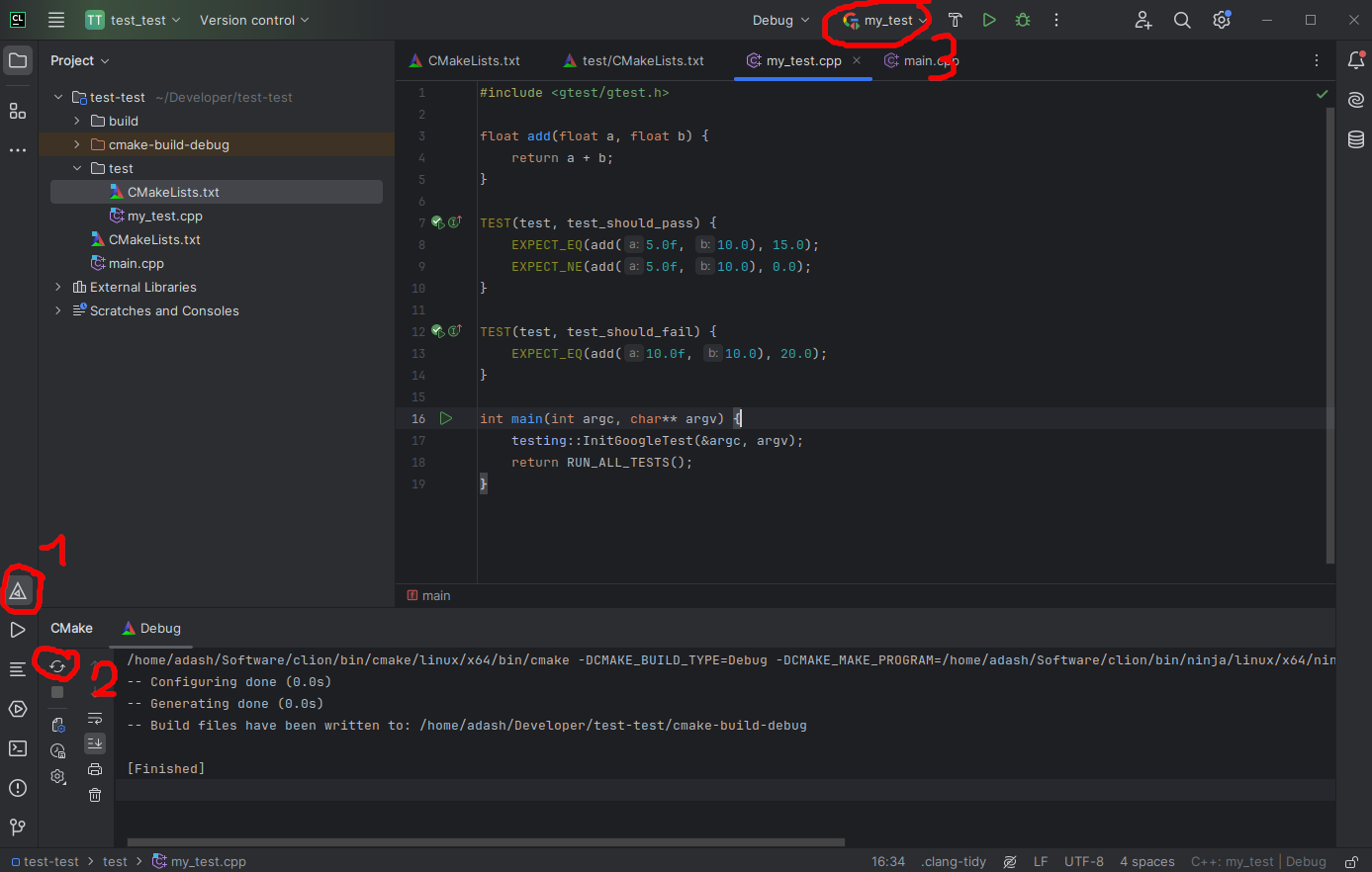Lab 2 - C++, CMake & IDE
Responsible: Ing. Adam Ligocki, Ph.D.
If you are not familiar with Linux CLI commands, please follow the Linux chapter.
CLI Compilation (30 min)
This exercise shows how to write and compile a basic C++ program on Linux.
In your home directory create a project folder and enter it.
Write a simple program into the main.cpp file.
#include <iostream>
#define A 5
int sum(int a, int b) {
return a + b;
}
int main() {
std::cout << "My Cool CLI Compiled Program" << std::endl;
int b = 10;
std::cout << "Sum result: " << sum(A, b) << std::endl;
return 0;
}
Save the file and compile it using g++ (the GCC C++ compiler):
g++ -o my_cool_program main.cpp
Then run the binary:
./my_cool_program
There are other alternatives, like Clang, LLVM, and many others.
Challenge 1
- In your project folder, create an
includefolder. - In the
includefolder, create alib.hppfile and write a simple function in it. - Use the function from
lib.hppinmain.cpp. - Compile and run the program (tip: use
-I <folder>with g++ to specify the header search path).
Challenge 2
-
In the project folder, create
lib.cpp. -
Move the function implementation from
lib.hpptolib.cpp; keep the function declaration inlib.hpp. -
Compile and run the program (tip: you have to compile both
main.cppandlib.cpp). -
Helper:
g++ -o <output_binary> <source_1.cpp source_2.cpp ...> -I <folder_with_headers> -
Discuss the difference between preprocessing, compiling, and linking.
-
Delete project folder
CMake Project (30 min)
Before continuing, get familiar with CMake.
Now let's create a similar project, but using CMake.
- Determine your current location in the file system.
- Switch to your home directory.
- Create a new project folder.
- Inside this folder, create several subdirectories so that the structure looks like this (use the tree command to verify):
/MyProject
|--build
|--include
| \--MyProject
\--src
- Using any text editor (like
nanoorvim), create the following files in the project root:main.cpp,lib.cpp,lib.hpp, andCMakeLists.txt. - Move (do not copy) the
main.cppandlib.cppfiles into thesrcsubdirectory. - Move the
lib.hppfile into theinclude/MyProjectsubdirectory. - Move the
CMakeLists.txtfile into the root of the project folder.
Now your project should look like this:
/MyProject
|--build
|--CMakeLists.txt
|--include
| \--MyProject
| \--lib.hpp
\--src
|--lib.cpp
\--main.cpp
- Using a text editor, fill the
main.cpp,lib.cpp, andlib.hppfiles with the required code. - Using a text editor, fill the
CMakeLists.txtfile.
cmake_minimum_required(VERSION 3.10)
project(MyProject)
set(CMAKE_CXX_STANDARD 17)
include_directories(include/)
add_executable(my_program src/main.cpp src/lib.cpp)
Now compile the project. From the project folder, run:
cd my_project_dir # go to your project directory
mkdir -p build # create build folder
cd build # enter the build folder
cmake .. # configure; looks for CMakeLists.txt one level up
make # build program
./my_program # run program
Optional: Try to compile the program manually.
g++ <source1 source2 source3 ...> -I <include_directory> -o <output_binary>
- Delete project folder
CLion IDE (30 min)
Create the same project using the CLion IDE.
To learn how to control CLion, please take a look at the tutorial or the official docs.
Unit Tests, GTest (30 min)
Unit tests are an effective way to develop software. Often called test‑driven development, the idea is: define the required functionality, write tests that cover the requirements, and then implement the code. When tests pass, the requirements are met.
On larger projects with many contributors and frequent changes, unit tests help catch regressions early. This supports Continuous Integration (CI).
There are many testing frameworks. In this course we will use GoogleTest (GTest), a common and well‑supported choice for C++.
GTest Installation
If there is no GTest installed on the system follow these instructions.
# install necessary packages
sudo apt update
sudo apt install cmake build-essential libgtest-dev
# compile gtest
cd /usr/src/gtest
sudo cmake .
sudo make
# install libs into system
sudo cp lib/*.a /usr/lib
Verify the libraries are in the system:
ls /usr/lib | grep gtest
# you should see:
# libgtest.a
# libgtest_main.a
Adding Unit Test to Project
In your project directory add the test folder.
/MyProject
|--include
|--src
\--test
Add the add_subdirectory(test) line at the end of CMakeLists.txt file.
Create CMakeLists.txt file in the test folder.
cmake_minimum_required(VERSION 3.10)
find_package(GTest REQUIRED)
include(GoogleTest)
enable_testing()
add_executable(my_test my_test.cpp)
target_link_libraries(my_test GTest::GTest GTest::Main)
gtest_discover_tests(my_test)
Create my_test.cpp file.
#include <gtest/gtest.h>
// Simple addition function for demonstration.
float add(float a, float b) {
return a + b;
}
TEST(AdditionTest, AddsPositiveNumbers) {
EXPECT_FLOAT_EQ(add(5.0f, 10.0f), 15.0f);
EXPECT_FLOAT_EQ(add(0.0f, 0.0f), 0.0f);
}
TEST(AdditionTest, AddsEqualNumbers) {
EXPECT_FLOAT_EQ(add(10.0f, 10.0f), 20.0f);
}
int main(int argc, char** argv) {
testing::InitGoogleTest(&argc, argv);
return RUN_ALL_TESTS();
}
In CLion, open the bottom console and run:
mkdir build && cd build
cmake ..
make
cd test
ctest
You should see the test output.
You can also run tests directly in CLion by reloading CMake; the test target will appear as an executable at the top of the window.

C++ Training (2h)
Take a look at the basic C++ tutorial and the more advanced multithreading tutorial.